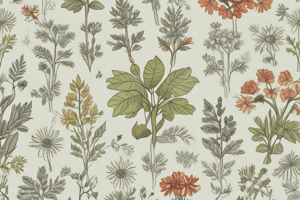Podcast
Questions and Answers
What is the primary factor that limits the growing season?
What is the primary factor that limits the growing season?
- Climate
- Elevation above sea level
- Frost days
- All of the above (correct)
In which regions does the growing season usually last all year?
In which regions does the growing season usually last all year?
- Temperate regions
- Higher latitudes
- Polar regions
- Tropical and equatorial regions (correct)
What is the effect of climate change on the length of the growing season in some parts of the world?
What is the effect of climate change on the length of the growing season in some parts of the world?
- It has increased the growing season (correct)
- It is unpredictable
- It has remained the same
- It has decreased the growing season
How can the length of the growing season be measured?
How can the length of the growing season be measured?
What is the definition of a growing season?
What is the definition of a growing season?
What is the primary difference between annuals and perennials?
What is the primary difference between annuals and perennials?
What happens to biennials in the first growing season?
What happens to biennials in the first growing season?
What is the main advantage of perennials in a garden?
What is the main advantage of perennials in a garden?
What is the primary characteristic of hardy annuals?
What is the primary characteristic of hardy annuals?
What determines how long ephemeral annuals last?
What determines how long ephemeral annuals last?
What is the characteristic of hardy annuals?
What is the characteristic of hardy annuals?
What is the primary difference between tender annuals and tender perennials?
What is the primary difference between tender annuals and tender perennials?
What is the characteristic of biennial plants?
What is the characteristic of biennial plants?
Which type of perennial plants support their leaves all year-round?
Which type of perennial plants support their leaves all year-round?
What is the primary similarity between biennials and perennials?
What is the primary similarity between biennials and perennials?
Study Notes
Seasons and Growing Seasons
- Seasons vary by temperature, weather, amount of daylight, and rainfall
- Plants go through seasons in different ways, some producing seeds and dying after a year or two, while others grow and produce seeds for many years
- A growing season is a period of time when plants can grow, limited by factors such as climate, elevation, frost days, temperature, daylight hours, and rainfall
- In tropical and equatorial regions, the growing season usually lasts all year, while in higher latitudes it may last for less than two months
Annual, Biennial, and Perennial Plants
- Annual plants complete their life cycle in one growing season
- Biennial plants take two seasons to complete their life cycle and die
- Perennial plants live on for many years, flowering every year
- The difference between annuals and perennials lies in the number of growing seasons they require to complete their life cycle
Characteristics of Annuals, Biennials, and Perennials
- Annuals:
- Complete life cycle in one growing season
- Die after producing seeds
- Examples: Marigold, Corn, Rice, Lettuce
- Biennials:
- Take two seasons to complete their life cycle and die
- Produce only leaves and roots during the first growing season
- Examples: Carrots, Parsley, Leek, Brussels Sprouts
- Perennials:
- Live on for many years, flowering every year
- Can come back year after year without dying
- Examples: Potatoes, Spruce, Chives, Broccoli, Sunflowers, Grasses
Types of Annuals
- Hardy annuals:
- Can tolerate cold soil, air, and light frosts without damage
- Examples: Ornamental Cabbage, Kale, Pansy, Snapdragon
- Half-hardy annuals:
- Can tolerate cool soil and air and moderate frost (28°F)
- Examples: Geranium, Lobelia, Petunia, Gazania
- Tender annuals:
- Cannot tolerate cool soil and air, will be killed by frost
- Examples: Begonia, Coleus, Vinca, Zinnia
- Tender perennials:
- If planted in warmer zones, can come back every year
- Cannot tolerate frost
- Examples: Tropical Hibiscus, Geranium, Lantana
Perennial Cycle
- Perennial plants can survive for many growing seasons because they have structures that allow them to endure extreme temperature or water changes
- Herbaceous plants may survive the dormant season through dieback and maintaining roots, rhizoids, bulbs, or tubers
- Woody perennial plants can be categorized into three major types: evergreen, deciduous, and semi-deciduous
Studying That Suits You
Use AI to generate personalized quizzes and flashcards to suit your learning preferences.
Description
Learn about the three categories of seasonal plants defined by their life cycle and growing seasons, including annual, biennial, and perennial plants.



